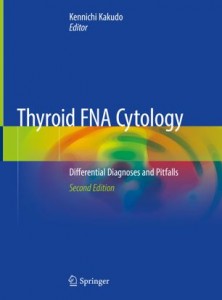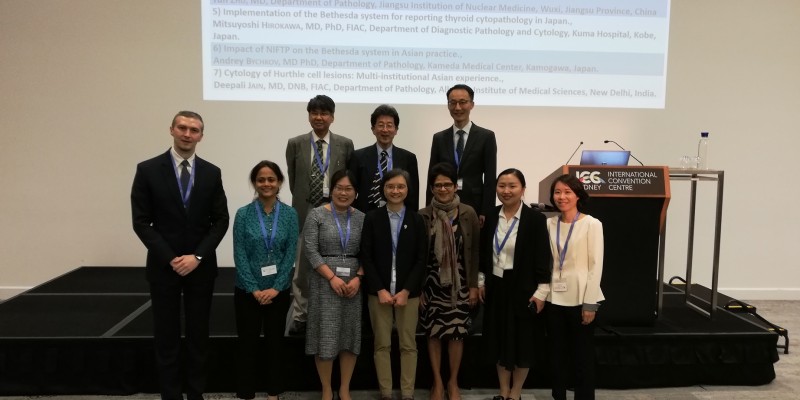Thyroid FNA Cytology, Differential Diagnoses and Pitfalls
2019/05/20
category: To Clinician , To pathologist , To Patient comment: (0)
Asian Working Group Companion Meeting in the 20th ICC Sydney.
2019/05/20
The 20th ICC Sydney was over with great success. Asian Working Group companion meeting was held on the 8th of May (Figure 1), and we had the third face to face meeting. Gradually we found significant differences in thyroid practice among Asian WG members as well as between Asian and Western thyroid practice more and more. We are proudly showed our recent activities.
Multi-institutional Studies in 2018 and 2019.
1. Bychkov A et al. Impact of noninvasive follicular thyroid neoplasm with papillary-like nuclear features on the Bethesda system for reporting thyroid cytopathology: a multi-institutional study in five Asian countries. Pathology 2018; 50:411-417.
2. Bychkov A et al. Noninvasive follicular thyroid neoplasm with papillary-like nuclear features in Asian practice: Perspectives for surgical pathology and cytopathology. Endocr Pathol. 2018; 29:276-288.
3. Vuong HG et al. Clinical impact of noninvasive follicular thyroid neoplasm with papillary-like nuclear features on the risk of malignancy in the Bethesda system for reporting thyroid cytopathology: a meta-analysis of 14,153 resected thyroid nodules. Endocr Pract. 2019 [Epub ahead of print]
4. Agarwal S et al. The prevalence and surgical outcomes of Hürthle cell lesions in fine‐needle aspirates of the thyroid: A multi-institutional study in six Asian countries. Cancer Cytopathol. 2019; 127:181-191.
5. Liu Z et al. Interobserver and intraobserver variation in the morphological evaluation of noninvasive follicular thyroid neoplasm with papillary like nuclear features in Asian practice. Pathol Int. 2019 [Epub ahead of print]
6. Kakudo K et al. To the Editor. Cytologically borderline thyroid nodules as a key target to reduce overdiagnosis and overtreatment of thyroid cancer. Arch Pathol Lab Med (Accepted for publication).
Please join us at the 58th JSCC Fall Meeting in Okayama, Japan. You and new members are also welcome to this activity. Please contact me at kakudo@thyroid.jp. The following are details for the 4th face to face meeting (the Global Asian Forum) on 16th of November in Okayama, Japan.
The Global Asian Forum: Thyroid FNA Cytology in Asian Countries.
Chairpersons:
1. Andrey Bychkov, MD, Ph.D., Department of Pathology, Kameda Medical Center, Kamogawa, Japan,
2. Kennichi Kakudo, MD, Ph.D., FIAC, Department of Pathology, Kindai University Faculty of Medicine, Nara Hospital, Ikoma, Japan,
A welcome message by the meeting president, professor Moriya
Speakers
1. Chan Kwon Jung, MD, Ph.D., Department of Hospital Pathology, College of Medicine, The Catholic University of Korea, Korea,
Topic: Nuclear features of BRAF mutated PTCs and RAS-mutated neoplasms.
2. Shipra Agarwal, MD, DNB, Department of Pathology, All India Institute of Medical Sciences, India,
Topic: AUS/FLUS in Indian experience with thyroid FNA.
2. Priyanthi Kumarasinghe, MD, Department of Anatomical Pathology, University of Western Australia, Australia,
Topic: BRAF testing to refine cytology categories: how and when?
4. Huyen-Trang Vu, MD, Department of Pathology, Ho Chi Minh City Oncology Hospital, Ho Chi Minh City, Vietnam,
Topic: Resection rate and risk of malignancy among TBSRTC categories in Western vs. Asian practice.
5. Chih-yi Liu, MD, FIAC, Division of Pathology, Sijhih Cathay General Hospital, New Taipei City, Taiwan,
Topic: Cytological diagnosis of medullary thyroid carcinoma among Asian Working Group in Thyroid Cytology.
6. Yaqiong Li MD Ph.D., Department of Pathology, Shandong Provincial Hospital Affiliated to Shandong University, Jinan 250021, Shandong, China,
Topic: Observer variation study in the diagnosis of follicular neoplasms.
category: To pathologist comment: (2)





